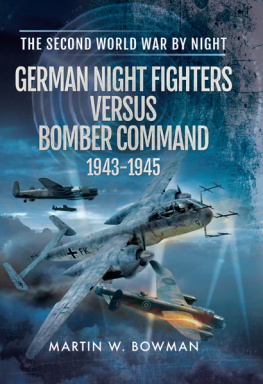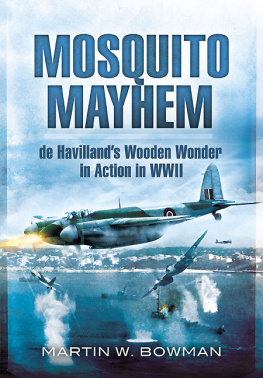First Published in Great Britain in 2016 by
Pen & Sword Aviation
an imprint of
Pen & Sword Books Ltd
47 Church Street, Barnsley, South Yorkshire S70 2AS
Copyright Pen & Sword Books 2016
ISBN: 9781473849792
PDF ISBN: 9781473849822
EPUB ISBN: 9781473849808
PRC ISBN: 9781473849815
The right of Martin W Bowman to be identified as author of this work has been asserted by him in accordance with the Copyright, Designs and Patents Act 1988.
A CIP catalogue record for this book is
available from the British Library.
All rights reserved. No part of this book may be reproduced or transmitted in any form or by any means, electronic or mechanical including photocopying, recording or by any information storage and retrieval system, without permission from the Publisher in writing.
Typeset in 10/12pt Palatino
by GMS Enterprises PE3 8QQ
Printed and bound in England by
CPI Group (UK) Ltd, Croydon, CR0 4YY
Pen & Sword Books Ltd incorporates the Imprints of Pen & Sword Aviation, Pen & Sword Family History, Pen & Sword Maritime, Pen & Sword Military, Pen & Sword Discovery, Wharncliffe Local History, Wharncliffe True Crime, Wharncliffe Transport, Pen & Sword Select, Pen & Sword Military Classics, Leo Cooper, The Praetorian Press, Remember When, Seaforth Publishing and Frontline Publishing.
For a complete list of Pen & Sword titles please contact
PEN & SWORD BOOKS LIMITED
47 Church Street, Barnsley, South Yorkshire, S70 2AS, England
E-mail:
Website: www.pen-and-sword.co.uk
Contents
Prologue
The German night fighters were just as clever, if not cleverer than ours. They had the aircraft to do it in and they were very good, the way they used to come in, particularly the various types of approaches. Even now you can get nightmares reading about some of the raids where they operated the Wild Sows and the offset guns and all the rest of it. You dont stand much chance in the Lancaster with pea-shooters which couldnt knock anything down. We were using those things from the Western Front in the First World War, the .303s. They had got a range of next to nothing.
With the German night fighters, theyd come in - some used to operate down below, some to one side - and position themselves with the upward-firing guns. They were a menace because theyd get on the blind side underneath the aircraft where no one could see them. Theyd wait for their moment, pull the throttles back, pull the nose up slightly and take a Lancaster from the nose right down to the tail with the cannon. Some of them didnt even do that. Theyd go for the wings and get the tanks first. Once youd got a twenty-mill cannon shell in the tanks; that was it. Oh, it was a very dicey business! It was a good thing half the people didnt know what was happening. Im sure they wouldnt have gone if they had!
Flying to Berlin some pilots took the view they should get in and out of the target as quickly as possible. Be the first one home, that way thered be less chance of getting hit. Theyd charge into the target, getting all they could out of the engines and to hell with whoever used the aircraft after them. They also knew that with lots of planes being damaged and others running out of petrol thered be hardly any airfields to land on. We always knew who they were because theyd get home about an hour before anyone else.
Sensible and reasonable pilots, and I regarded myself as one, would be careful how they used the engines and would take indirect routes, so they arrived back later. I always tried to fly so that there would be about two hours of petrol left when I got back to England. I flew around for twenty minutes and then came in. An experienced pilot would bide his time: he was safe while he was up there.
War In The Air compiled by Edward Smithies
Chapter 1
The Prinz Of The Darkness
he was boundlessly disillusioned and boundlessly disappointed. In 1943 he contemplated the thought of shooting Hitler. It was only out of sense of honour and duty that Heinrich went on fighting, carried along by the ambition to overtake Major Lent in his score of enemy aircraft shot down. In her memoirs, Tatiana von Metternich reported that Wittgenstein planned to kill Hitler after the ceremony at which he received his Knights Cross in 1943. He said, I am not married, I have no children - I am expendable. He will receive me personally. Who else among us can ever get as near to him?
Princess Walburga, Baroness von Friesen (1885-1970) mother of Heinrich Alexander Ludwig Peter Prinz zu Sayn-Wittgenstein who at the time of his death was the highest scoring night fighter pilot in the Luftwaffe and still the third highest by the end of World War II, with 83 aerial victories.
Slimly built, with a slender face and high forehead his bearing was that of a confident, well-educated man of good family. He was ambitious, intelligent and forthright, highly strung, too intense. Deep, abiding patriotism was the foundation of his character. Service as an officer in the armed forces was his family tradition and his youthful goal.
Little else in life meant anything to him but service to his nation.returned to pilot school and took his Luftwaffe Advanced Pilots Certificate 2, confirming proficiency for blind-flying, a pre-requisite for night duty and returned to a combat unit in March 1941. In preparation for Operation Barbarossa, the German invasion of the Soviet Union, his unit moved to Eichwalde in East Prussia. In support of Heeresgruppe Nord (Army Group North), KG1 flew its first sorties against Liepja and then Jelgava and Riga, targeting the heavily-occupied enemy airfields. In August 1941 Sayn-Wittgenstein transferred to the night fighter force. By this time, he had flown 150 combat sorties and was awarded both classes of the Iron Cross, Honour Goblet of the Luftwaffe and the Front Flying Clasp of the Luftwaffe for Bomber crews in Gold.
Sayn-Wittgenstein volunteered for the night fighter force and was appointed Staffelkapitn of 9./NJG2 on 1 November 1941. He claimed his first night Abschuss (victory); a Bristol Blenheim forty kilometres (25 miles) west of Walcheren on the night of 6 May 1942. He shot down three aircraft in both the nights of 31 July (victories 15-17) and 10 September (victories 19-21), receiving the Knights Cross (Ritterkreuz des Eisernen Kreuzes) on 7 October after 22 Abschsse. The award was presented by General Josef Kammhuber, after which they both inspected the personnel of 9./NJG2. Appointed Gruppenkommandeur of IV./NJG5 on 1 December, Hauptmann Sayn-Wittgenstein was moved to the Eastern Front in February 1943. Unteroffizier Herbert Kmmritz, who had six months of operational Bf 110 experience with II./NJG3 at Stade, joined Sayn-Wittgensteins crew as his bordfunker. Kmmritz had studied high frequency technology at the Telefunken Company in Berlin before the war. Prior to Kmmeritz, Sayn-Wittgenstein had rejected all his previous radio operators after only a few sorties.
In late spring 1943 Kammhuber ordered IV./NJG5 to relocate to Rennes, France in defence of the German U-boat bases. At Gilze-Rijen the order was issued to convert to the Bf 110 night fighter. Sayn-Wittgenstein flew the Bf 110 for one short flight only, but on the night of 24 June, the aircraft had technical problems and was considered unserviceable. Kmmeritz and Sayn-Wittgenstein took off in their usual Ju 88C and shot down four Lancasters (victories 3235). Sayn-Wittgenstein never flew another Bf 110 again, preferring his Ju 88 to the Bf 110. The gruppe was relocated to the Eastern Front again and re-designated as I./NJG100 on 1 August 1943. While stationed at Insterburg, East Prussia, Sayn-Wittgenstein shot down seven aircraft in one sortie; six of them within 47 minutes (victories 36-41), in the area north-east of Oryol on 20 July. He claimed three more victories on 1 August (victories 44-46) and three more on the night of 3 August (victories 48-50). He was appointed Gruppenkommandeur of II./NJG3 on 15 August. Sayn-Wittgenstein became the 290th recipient of the Knights Cross with Oak Leaves (Ritterkreuz des Eisernen Kreuzes mit Eichenlaub) after 54 aerial victories on 31 August. The award was presented at the Fhrerhauptquartier in East Prussia on 22 September. For these achievements he also received a letter from the commanding general of 4 Jagddivision Generalleutnant Joachim-Friedrich Huth. On 1 December Sayn-Wittgenstein was ordered to take command of II./NJG2.
Next page
















